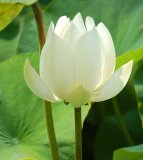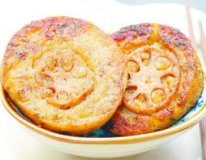   Origin: Lotus root is the fat root of a plant Nelumbo nucifera Gaertn., belonging to the lotus-lily family (Nymphaeaceae) of the water-lily order (Nymphaeales). This species is found in tropical and subtropical Middle East and Asia, from Egypt eastwards to Iran, India, China, Japan and Australia. The other speices of the order is the American lotus, or water chinquapin (N. lu tea, or N. pentapetala), found in the eastern United States and southward to Colombia. There are a number of freshwater plants called water lily that belong to the order Nymphaeaceae, comprising eight genera native to the temperate and tropical parts of the world. All members of the order are perennial except for the genus Euryale, an annual or short-lived perennial found only in Asia. The family Nymphaeaceae is characterized by circular, centrally stalked, slightly hairy leaves up to about 60 cm across, with the margins turned up, forming a funnel- or saucer-shaped depression. The leaves extend, in the Asian species, as much as 2 m above the water instead of floating on it. The large, attractive flowers also stand high above the water on strong, leafless stalks. They may be up to 25 cm across and have a number of petals, which close at night. The flowers of the Nelumbo nucifera, which stand as much as 1.8 m above the water, are pink or rose-colored and fragrant. It is in flower from July to August. The scented flowers are hermaphrodite (have both male and female organs). The American lotus has pale yellow flowers that rise about 60 cm above the water. Many varieties of the sacred lotus exist in cultivation, including dwarf forms and color varieties ranging from white to red. It cannot grow in the shade but can grow in water. The plant's many nutlike fruits are produced in the flat upper surface of a spongy receptacle or expanded, fleshy, capsulelike structure, which is wider at the upper end than at the base. The whole structure dries at maturity, breaks off, and floats about, releasing the seeds, actually the true fruits, through numerous holes in the flat surface. The seeds sink to the bottom and establish new plants. The dried receptacles are used by florists in dried arrangements. The whole plant of both species is edible. The rhizomes of Nelumbo nucifera are eaten in Asia either boiled or preserved in sugar and are the source of the starch known as lotus meal. The boiled young leaves are eaten as a vegetable. Even the stamens are used in Southeast Asia for flavoring tea. The American lotus is similarly edible, especially the large rhizomes, which were once a source of starchy food for the American Indians. The plants are particularly beneficial to wildlife. Beaver, for instance, eat the rootstocks, and fish obtain shade and shelter among the underwater portions of the plants. The seeds of the Oriental lotus have been ascribed remarkable powers of longevity and, under ideal conditions, may survive many years. Seeds recovered from an ancient peat bog in Manchuria have been shown by radioactive carbon dating to be some 1,000 years old, yet were capable of germinating. In China, lotus is mainly produced in the provinces Zhejiang, Jiangsu, Anhui, Hunan, Hubei, etc. Reaped in autumn and winter, the node is cut off when the lotus rhizome is dug out, then washed clean and dried in the sun for use when raw or after being parched. Lotus is also called Sacred Water Lotus, Sacred Lotus, and Chinese Arrowroot. See also Herbs, Hemostatics, Lotus Node; and Herbs, Astringents, Lotus Seed. Properties: Sweet in flavor, cool in nature (cooked lotus root is slightly warm in nature), it is related to the channels of the spleen, stomach and heart. Functions: Raw lotus root can clear away heat, cool the blood, dissipate blood stasis, it is a conventional hemostatic agent and used for thirst and fever in febrile diseases (fever), to treat restlessness, nose-bleeding and strangury (slow and painful spasmodic discharge of urine drop by drop) of the heat type. Cooked lotus root can strengthen the spleen, promote the functional activity of stomach, replenish the blood, promote the tissue regeneration and arrest diarrhea. Lotus node, when parched, can arrest bleeding and dissipate blood stasis, is used to shorten bleeding and blood coagulation times. The decoction of lotus node, when taken orally, can check upward adverse flow of qi and regulate the middle-jiao. Lotus seeds are nourishing and sedative. The leaves, the pod of the seeds and stem are hemostatic and astringent (causing contraction). Applications: 1. For all kinds of bleeding: Boil 500 g lotus root to obtain concentrated juice. It can be used constantly. For inner heat due to yin deficiency, it is also very helpful. 2. For heat-phlegm and coughing: Prepare equal amount of juice from pear and lotus root and serve as one would tea. 3. For dribbling urine of the heat type: Prepare fresh juice from fresh lotus root, grapes and rehmanniae root. Add a little bee honey and serve as tea. 4. For vomiting and thirst: Use 30 g fresh lotus root, 3 g fresh ginger. Squeeze both to obtain juice and divide it into 3 doses for daily use. Dosage and Administration: To be eaten raw, cooked, or pounded to get its juice for drinking. It can be dried in the sun and ground into powder for making porridge. Cautions on Use: Reference Materials: On Properties of Herbs : "This herb is blended into juice for the treatment of incessant hematemesis (vomiting of blood)." The Compendium of Materia Medica : "Hematemesis, bloody sputum, strangury (slow and painful spasmodic discharge of urine drop by drop) complicated by hematuria (blood in urine), hematochezia, dysentery with bloody stools, metrorrhagia and metrostaxis." Modern Researches: Lotus root is rich in starch, tannate protein, asparagine, pyrocatechol, d-gallic-catechin, neochlorogenic acid, leucocyanidin, leucodephinidin, peroxidase, vitamins B and C. The stem contains alkaloid, resin and tannate. All parts of the plant are used, they are astringent, cardiotonic (increase the tonus of heart muscle), febrifuge (herb that reduces fever), hypotensive (lowering blood pressure), resolvent, stomachic, styptic (to contract or bind, astringent), tonic and vasodilator (widening of the lumen of blood vessels). The leaves are rich in nuciferine, nornuciferine, roemerine and quarcetin. The leaf juice is used in the treatment of diarrhoea and is decocted with liquorice (Glycyrrhiza spp) for the treatment of sunstroke. A decoction of the flowers is used in the treatment of premature ejaculation. The flowers are recommended as a cardiac tonic. A decoction of the floral receptacle is used in the treatment of abdominal cramps, bloody discharges etc. The flower stalk is haemostatic. It is used in treating bleeding gastric ulcers, excessive menstruation, post-partum haemorrhage. The stamens are used in treating urinary frequency, premature ejaculation, haemotysis, epistacis and uterine bleeding. A decoction of the fruit is used in the treatment of agitation, fever, heart complaints, etc. The seeds and intersegmental parts (lotus nodes) are rich in asparagin, fat, protein, starch and tannin. The seed is sedative. It is used in the treatment of poor digestion, enteritis, chronic diarrhoea, insomnia, palpitations etc. The plumule and radicle are used to treat thirst in high febrile disease, hypertension, insomnia and restlessness. The root is tonic. The root starch is used in the treatment of diarrhoea, dysentery, etc., a paste is applied to ringworm and other skin ailments. It is also taken internally in the treatment of haemorrhages, excessive menstruation and nosebleeds. The plant has a folk history in the treatment of cancer, modern research has isolated certain compounds from the plant that show anticancer activity. (责任编辑:admin) |
